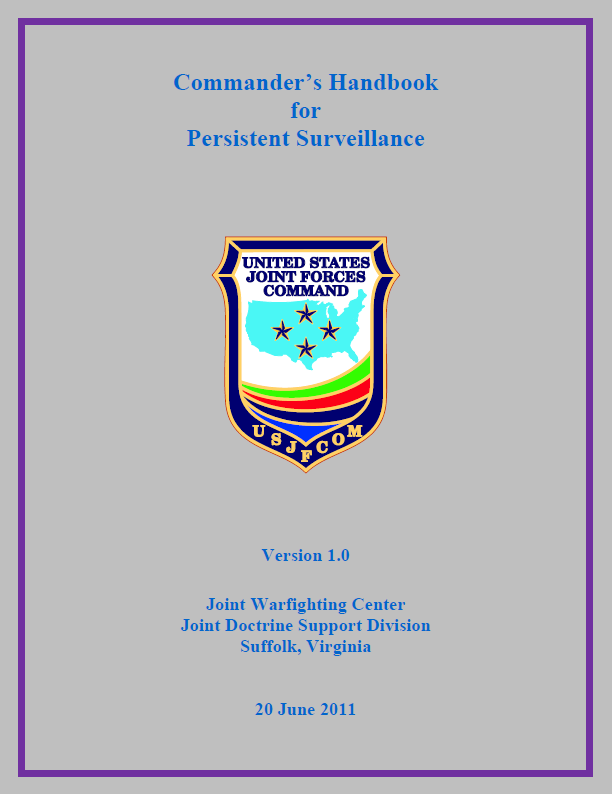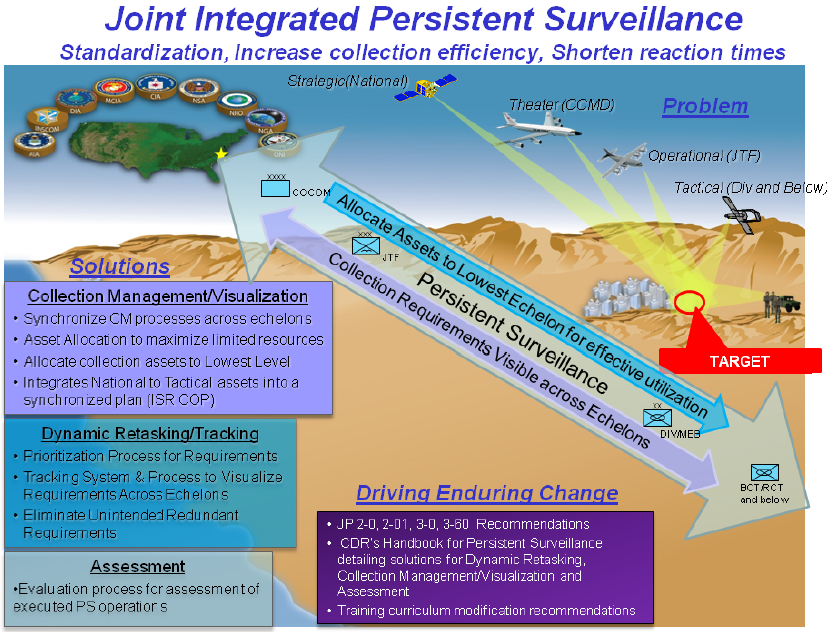The following handbook related to persistent surveillance, particularly in relation to unmanned aerial vehicles (UAVs), was released by the U.S. Joint Forces Command in 2011. Thanks to er0tikka for pointing the handbook out to us.
Commander’s Handbook for Persistent Surveillance
- 106 pages
- June 20, 2011
- 2.99 MB
This handbook provides pre-doctrinal guidance on the planning, execution, and assessment of joint integrated persistent surveillance (JIPS) by a joint task force (JTF) and its components. Significant prior work has been done in support of persistent intelligence, surveillance, and reconnaissance (ISR) and much of the information in this handbook was gleaned from that data. However, the scope of this handbook pertains to the subset of persistent surveillance: the processes which contribute to creating a persistent surveillance strategy and those required for executing persistent surveillance missions. The document serves as a bridge between current best practices in the field and incorporation of value-added ideas in joint doctrine.
2. Purpose
This handbook draws on current doctrine, useful results from relevant studies and experimentation, and recognized best practices. It presents some challenges of persistent surveillance to include capability gaps and some potential solutions to these shortfalls, especially in the areas of planning and preparation, managing requirements and tasking, visualization and tracking, and assessment of persistent surveillance missions. It also offers some considerations for the future development of JIPS-related joint doctrine, training, materiel (logistics), leadership education, personnel, facility planning, and policy (DOTMLPF-P).
3. Application
This handbook is based on joint lessons and Service learned data; joint, multinational, and Service doctrine and procedures; training and education material from CAPSTONE, KEYSTONE, and PINNACLE senior executive education programs; joint and Service exercise observations, facilitated after-action reviews and commander’s summary reports; related joint concepts; experimentation results; joint exercises and trip reports; joint publication assessment reports; research from advanced concept/joint capability technology development projects and capability development documentation for acquisition programs, and DOTMLPF-P change recommendations. This handbook also includes the results of a two-year analysis and experimentation effort conducted by Joint Doctrine Support Division and Solution Evaluation Division, with participation by all the Services. The JIPS project was driven by the following military problem statement: “The JFC requires adequate capability to rapidly integrate and focus national to tactical collection assets to achieve the persistent surveillance of a designated geographic area or a specific mission set.” The genesis/mandate was that five of the top 40 FY 09-10 priority warfighter challenges (WFCs) require persistent surveillance solutions (WFCs 2, 4, 13, 20, 30) as reported by USPACOM, USCENTCOM, and the Marine Corps Combat Development Command. Experimentation included a stakeholder conference; baseline assessment; a constructive simulation effort; a “human-in-the-loop” experiment; and a multi-Service, coalition, live-fly environment experiment that simulated operations in Afghanistan (EMPIRE CHALLENGE 2010). Development of the JIPS handbook is tied to the four major outcomes from experimentation and reflects concepts of operations developed for the proposed DOTMLPF-P change recommendation submission.
…
1. Persistent Surveillance Overview
a. Persistent surveillance missions do not occur in a vacuum; rather, they are tied to a commander’s mission, intent, commander’s critical information requirements (CCIRs), and the overall collection plan. Any persistent surveillance mission has to be managed within the confines of commander’s guidance and intent for that operation within the context of the overall unit mission.
b. Persistent surveillance missions can last for days and may require constant surveillance from multiple assets working in a synchronized manner. This is especially true when considering 24 hour operations (where assets may operate in shifts) and down time is a planning factor. Planners and collection managers have to maintain an objective view of the trade-off of costs to other collection requirements and the benefits of assigning assets to a specific mission. A recommendation may have to be made to the commander to end a persistent surveillance mission that is too expensive in terms of asset hours or loss of collection against other priority requirements.
c. Persistent surveillance missions require the active involvement of commanders and their operations and intelligence staffs. Commanders of all echelons involved in persistent surveillance mission planning must determine the priority of their mission as it relates to the operations of their higher headquarters. Persistent surveillance missions potentially take a large amount of time and result in tasking of multiple assets and must be assessed against other operational and intelligence missions in the area of operations. The commander’s priority of effort must be conveyed to the staff officers who have tasking authority over the required operational and intelligence assets.
d. Each persistent surveillance mission evolution requires detailed planning and focus on a chain of collection tasks that need to be synchronized and managed as a coherent whole. This “system-of-systems” approach to persistent surveillance missions is in itself a part of a larger collections system. The proper management and prioritization of requirements, combined with detailed situational understanding of the ongoing operation, and rapid identification and resolution of deficiencies or gaps in collection during the mission, are necessary to meet the needs of the commander in a successful persistent surveillance mission.
e. Changes in the target or asset availability must be instantly communicated to all interested parties, including commanders, asset managers and the responsible operations center. The establishment and maintenance of a common operational picture (COP), or user defined operational picture (UDOP) available to all required personnel at multiple echelons, is absolutely vital to conducting successful persistent surveillance missions.
f. There are many possible reasons for the dynamic re-tasking of an asset to support a persistent surveillance mission. It is not always possible to predict when retasking is required; however, a good understanding of the OE can support smoother and more efficient re-tasking opportunities. Operational staffs should prepare as much as possible in order to rapidly and effectively conduct dynamic re-taskings should the need arise. Re-tasking issues are discussed in Chapter IV, “Managing Requirements and Tasking.”
g. Commanders can greatly reduce the time required to act on an immediate retasking requirement by maintaining awareness of environmental changes, other ongoing operations, and other assets in the area that could be used in a dynamic re-tasking situation. A shared COP/UDOP is a vital tool to rapidly identify necessary situations for re-tasking and to effectively coordinate between higher, lower and adjacent units.
h. While conducting persistent surveillance missions, there is always the possibility that a staff will have target fixation and concentrate on the ongoing mission while ignoring or downplaying other requirements. The persistent surveillance target has to be viewed in relation to the “big picture” of the overall operation. Throughout the life of a persistent surveillance mission, there will be many additional requirements that will have to be dealt with and incorporated into ongoing collection operations.
i. Commanders and decision makers must be aware at all times of the other high priority requirements that are being addressed in their area of operation, influence and interest. This will help identify what units and intelligence assets are unavailable for dynamic re-tasking requirements, and also if some higher priority event could call for the cancellation of the persistent surveillance mission and the refocusing of previously tasked assets on that new requirement.
…


